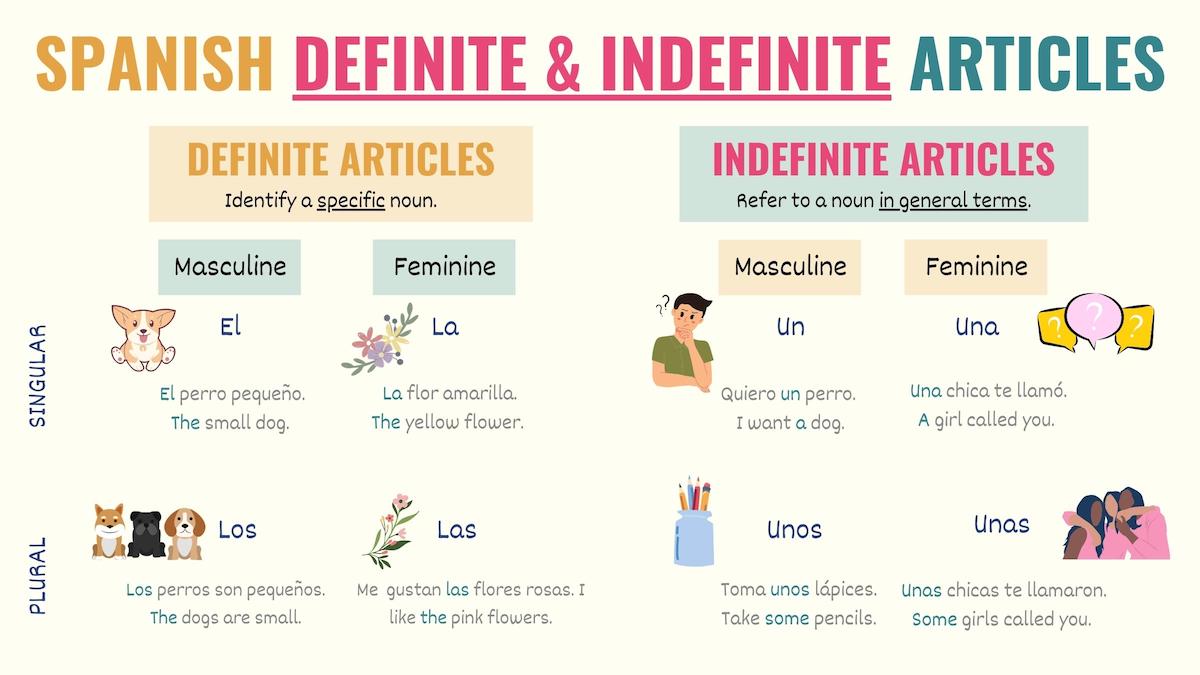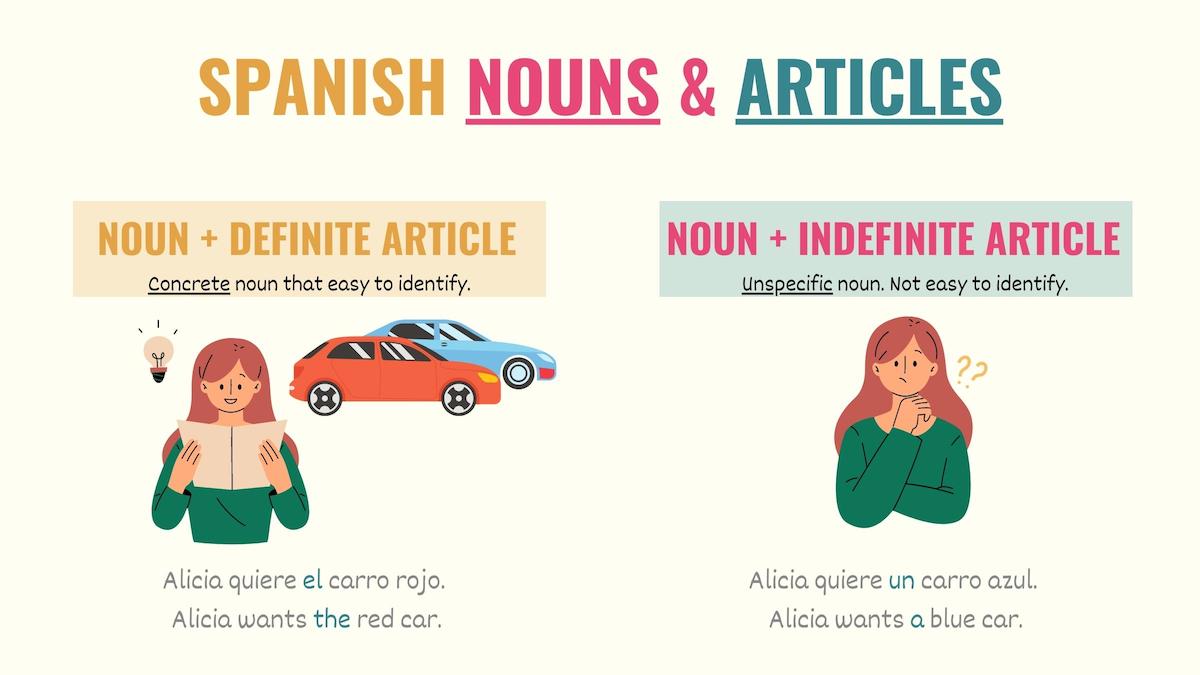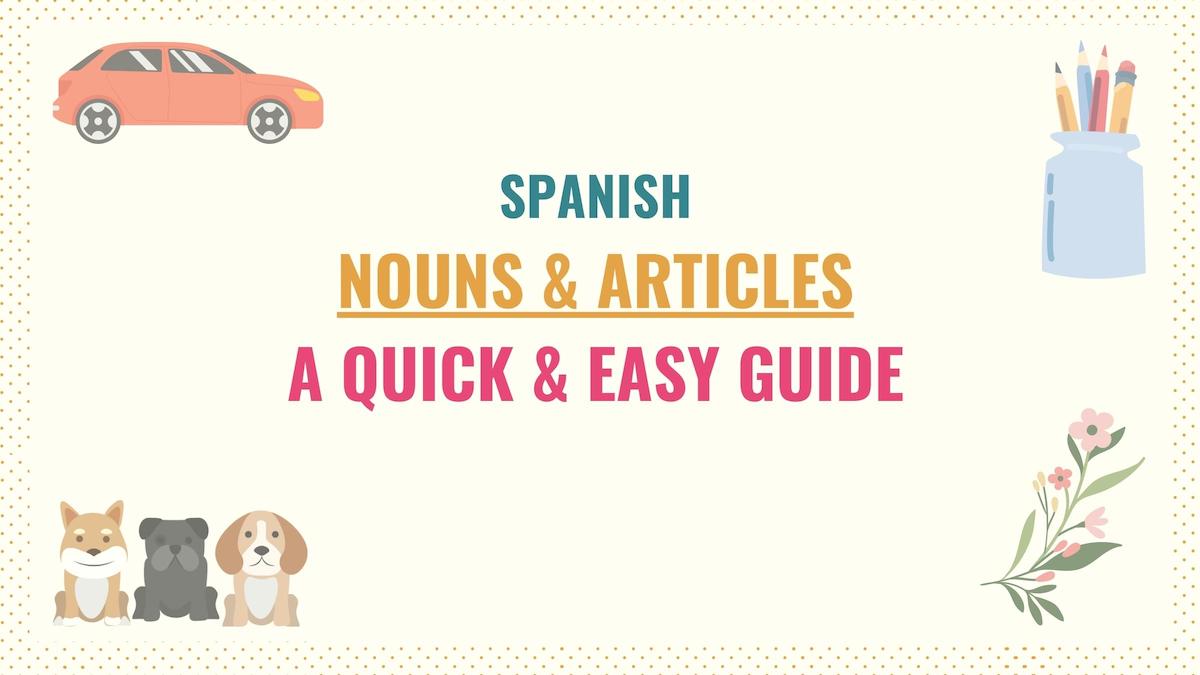Nouns and articles are words that often work together in a sentence. Because of this, you must get familiar with some basic rules on how to combine nouns and articles in Spanish correctly.
In this guide, we’ll go over:
- Nouns & Articles: How to Use Them
- When Nouns Do Not Need an Article
- Key Points
- Downloadable PDF
- Additional Resources
I’ve included simple sentences and examples to make this guide as comprehensive as possible. Let’s get started!
How to Use Nouns and Spanish Definite & Indefinite Articles
Spanish nouns are frequently paired with an article to communicate how specific that noun is. Based on their degree of specificity, articles are classified into:
- Definite
- Indefinite

In Spanish, an indefinite article is used to refer to a thing, person, place, or idea in a general and imprecise way. Depending on the noun’s gender and whether it’s singular or plural, there are four indefinite articles in Spanish:
Singular indefinites
- Un (masculine)
- Una (feminine)
Plural indefinites
- Unos (masculine)
- Unas (feminine)
Take Note: Do not confuse the indefinite article un (a, an) with uno (one). ‘Uno’ is a definite pronoun that replaces a noun while expressing amounts. Un always precedes a noun.
On the other hand, a Spanish definite article combined with a noun conveys specificity. In other words, you’re referring to concrete nouns whose identity is known by the people involved in the conversation.
There are four definite articles to mark the gender and number of the word they accompany:
Singular
- El (masculine)
- La (feminine)
Plural
- Los (masculine)
- Las (feminine)
Examples
Below are some sentences using these two types of words. Notice the nuance in meaning with examples containing a definite article vs an indefinite.
[Article] + [noun]
Example #1:
La pelota negra es mía.
The black ball is mine.
Creo que Juan tiene una pelota.
I think Juan has a ball.
Example #2
Deja los zapatos aquí.
Leave the shoes here.
Necesito unos zapatos nuevos.
I need a new pair of shoes.
Example #3
Yo quiero el carro rojo.
I want the red car.
Mis hermanos quieren un carro.
My brothers want a car.
Check example #3. When using the indefinite article un, we convey that my brothers want any car—no particular brand, color, or model.
However, using the definite article el allows me to express that I have a specific car in mind (el rojo), and the people I’m talking to can easily identify it (they can see it or have heard about it).

Number & Gender Agreement with Spanish Articles
Like adjectives and certain determiners, an article must agree with the noun’s gender and number. This means that a noun has a gender (masculine or feminine) or a singular or plural form (number) and the article must also display this information.
For example:
El gato negro.
The black cat.
Los gatos de Alicia.
Alicia’s cats.
Me gusta la casa azul.
I like the blue house.
Las casas azules son muy bonitas.
The blue houses are very pretty.
In example #1, we’re talking about a single black cat, as a result, we must use el (singular masculine article). However, in example #2, gatos is no longer singular, but plural. So, to fulfill these noun and article agreement rules, we must use the article los.
The same happens with feminine singular and plural words (examples #3 and #4). Notice that articles are always placed before nouns.
Take Note: Singular feminine words that start with an a (like agua) use the definite article el to ease the pronunciation. Despite this, these nouns are still feminine.
Do Nouns in Spanish Always Need an Article?
Although they often work together, in Spanish, there are certain situations where nouns don’t need to be preceded by an article:
1. Saying someone’s profession
Lilly es maestra de español.
Lily is a Spanish teacher.
2. Using proper nouns or years
Me gusta España.
I like Spain.
Take Note: Some proper nouns of cities, rivers, or mountains may be formed with a definite article (El Paso, El Salvador). you cannot omit the article because it’s part of that place’s name.
3. Using uncountable nouns
Necesitamos leche.
We need milk.
Take Note: With uncountable nouns in Spanish, you may use articles only if you’re describing that noun or are talking about something specific. For instance: La leche que compramos (the milk we bought).
In addition to these rules, nouns can work with other Spanish determiner words when you need to convey different information about that noun, such as possession or proximity. Check the difference:
La niña es muy tranquila.
The girl is very quiet.
Mi prima es muy ruidosa.
My cousin is very noisy.
Key Points
Spanish articles and nouns are words you’re going to use frequently in your sentences. Here are the key points to keep in mind:
- Articles in Spanish convey how specific a noun is.
- Indefinite articles refer to nouns in a non-specific way. It could be any place, thing, or person.
- A definite article + a noun conveys specificity. Spanish definite articles refer to a specific noun that is easy to identify by the people involved in the conversation.
- Articles in Spanish must agree with the gender and number (singular or plural form) of a noun.
Download the Articles & Nouns PDF Cheat Sheets
Just like when you learn how English articles work with nouns, it can take some time to really master a new Spanish grammar topic. I’ve created a PDF you can download containing the graphics, rules, and examples on how to use these two parts of speech together. You’ll find tons of examples and combinations including using plural definite articles (los and las) with plural nouns as well as singular, masculine and feminine nouns.
Next Steps: Additional Resources for Learning Nouns & Articles
Now that you’ve learned how nouns and articles work together, your next task is to learn adjectives and other determiners you can pair with nouns. Like articles, these types of words need to agree with the noun!
Remember that in Spanish words have gender. Simply put, this means that a noun can be feminine or masculine. For the most part, nouns ending in a are likely to be feminine whereas most nouns ending in o would be masculine.
However, there are some exceptions to this rule and other endings you must know to understand how the rules for the gender of words works in Spanish.



